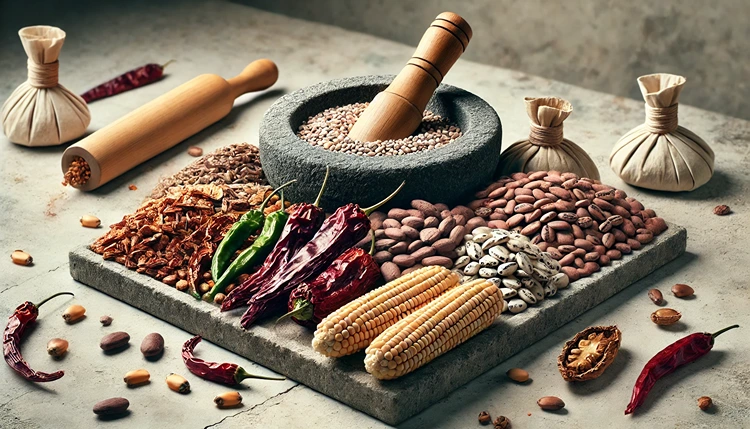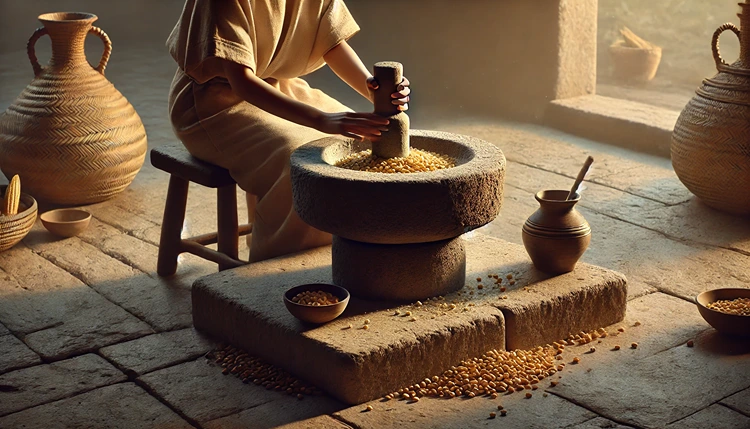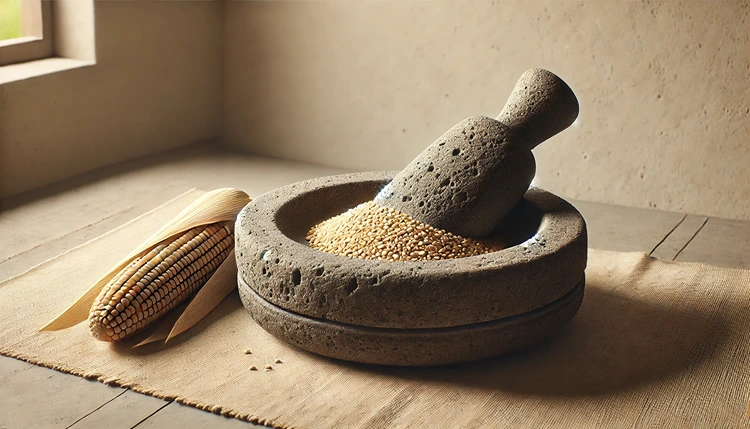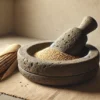Stone grinding played a vital role in the daily culinary practices of the Aztec civilization. From preparing basic staples like corn for tortillas to grinding spices and seeds, stone tools were indispensable. In today’s modern kitchens, we have high-tech gadgets to take care of the heavy lifting, but the Aztecs had something much simpler: stone grinders. These simple tools were responsible for creating the flavors and textures that formed the backbone of their diet. So, let’s explore the fascinating world of stone grinding in ancient Aztec cooking.
Why Was Stone Grinding So Important in Ancient Aztec Cooking?
At the heart of the Aztec diet were foods like maize, beans, and chili peppers. These staple ingredients needed to be ground down to make them usable for daily meals. Without the tools to properly grind maize, for example, you wouldn’t have tortillas, tamales, or even atole—a beloved Aztec drink. Stone grinding was the technology that allowed these ingredients to be transformed into the diverse array of foods that sustained the Aztec people.
Helpful Hint:
When thinking about stone grinding, imagine how much effort went into creating everyday foods like tortillas. The process was labor-intensive, but the results were worth it. Freshly ground corn meal or spices always produced richer flavors compared to pre-ground products.
What Tools Were Used for Stone Grinding?
When we think about stone grinding in ancient Aztec cooking, two key tools come to mind: the metate and the mano. The metate is a flat or slightly concave stone slab, while the mano is a cylindrical stone used to grind food by pressing it against the metate. These tools were typically made from volcanic rock, which provided the rough texture necessary to break down grains and seeds efficiently.
How Were These Tools Made?
The metate and mano were made from durable stones like basalt, which could withstand daily use without wearing down too quickly. These stones were carefully shaped and smoothed, but not to the point where they lost their roughness—after all, the coarse surface was what made them effective at grinding. Skilled artisans would craft these tools, and they were often passed down through generations, treasured for their ability to produce fine, uniform results.
What Foods Were Prepared Using Stone Grinding?

Stone grinding wasn’t just for maize; it was used for a variety of foods and ingredients essential to Aztec cooking.
- Maize: Ground maize was used to make masa, the dough used for tortillas, tamales, and other essential foods.
- Chili Peppers: Dried chili peppers were often ground into a powder or paste to add flavor and heat to many dishes.
- Seeds and Nuts: Amaranth seeds, pumpkin seeds, and even cacao were ground to make rich sauces or drinks like chocolate.
Each ingredient had its own unique texture and consistency when ground, and the metate was essential for achieving the right results.
Traditional Uses of Stone Grinding in Aztec Cooking
| Ingredient | Traditional Use |
|---|---|
| Maize | Ground to make masa for tortillas, tamales, and atole. |
| Cacao | Ground for making spiced chocolate drinks like xocoatl. |
| Chili Peppers | Ground into a paste or powder for seasoning various dishes. |
| Amaranth | Ground for porridge or used in ceremonial food offerings. |
| Pumpkin Seeds | Ground for use in sauces like mole. |
| Agave | Ground to prepare pulque, a traditional alcoholic drink. |
How Did Stone Grinding Impact the Flavors in Ancient Aztec Cooking?
The process of stone grinding didn’t just make ingredients more usable—it also impacted the flavor of the food. Grinding fresh ingredients on a stone surface helped release essential oils and flavors that would otherwise remain locked inside the seeds, nuts, or grains. This is why traditional stone-ground foods, like fresh masa, often have a deeper, more complex flavor compared to their modern counterparts.
Helpful Hint:
If you’ve ever tried freshly ground spices, you know the difference in flavor intensity compared to pre-ground versions. The same principle applies to stone-ground corn or seeds—those extra oils and textures add depth to any dish.
How Did Stone Grinding Fit Into Daily Aztec Life?
In Aztec society, food preparation was a daily ritual that was often carried out by women. The process of grinding maize for tortillas could take hours, and it was physically demanding. Still, this was a cornerstone of Aztec culture. The repetitive motion of grinding, the feel of the stone beneath their hands, and the transformation of ingredients into something edible were all part of the daily rhythm of life.
Stone grinding wasn’t just about food—it was also a social activity. Women would gather to grind maize together, sharing stories and strengthening community bonds. The simple act of using a metate and mano connected the people to their food in a way that modern kitchens rarely do.
Grinding was also essential for preparing food for special occasions and ceremonies. Certain dishes required a finer grind, and this extra effort added to the significance of these foods during rituals.
Are There Modern Uses for Stone Grinding in Cooking?
Though we have modern appliances that make food preparation much easier today, there’s been a resurgence in the appreciation for traditional methods like stone grinding. Many chefs and home cooks prefer stone-ground ingredients for their superior flavor and texture. You might even find artisanal tortilla makers or restaurants that use metates to grind fresh masa for their dishes, embracing the ancient traditions of the Aztecs.
Helpful Hint:
If you’re interested in trying stone grinding at home, small metates and manos can be found at specialty kitchen stores or online. While it may take more effort than using a blender or food processor, the result is a unique and flavorful experience.
How Did the Aztecs Use Stone Grinding for Cacao?

When we think of cacao, we usually think of chocolate, but the Aztecs used cacao primarily as a beverage and as currency. Stone grinding was essential to their process of turning cacao beans into a smooth, rich paste that could be used for making xocoatl—a bitter, spiced chocolate drink. The beans were roasted, and then ground on a metate until they released their natural oils, forming a thick, fragrant paste. This paste was often mixed with water, chili, and spices to create the drink that was enjoyed by Aztec nobility.
The grinding process helped release the oils from the cacao, giving the drink its signature texture and deep, complex flavor. Unlike the sweet chocolate we enjoy today, the Aztec version was spicy, bitter, and had a more earthy taste, all thanks to the traditional stone grinding technique.
What Role Did Stone Grinding Play in Aztec Rituals?
Stone grinding wasn’t limited to daily meals; it also played a critical role in religious and ceremonial life. The Aztecs believed that food offerings were necessary to appease their gods, and the preparation of these offerings was done with great care. Corn, cacao, and other ground ingredients were often used in special dishes prepared for festivals and sacrifices. For instance, during the celebration of Huitzilopochtli, the god of war, corn dough was shaped into images of the god, and these sacred offerings were prepared with ingredients ground using traditional stone tools.
The laborious process of stone grinding elevated the spiritual significance of the food. It was believed that the more effort that went into preparing a dish, the more pleasing it was to the gods. Stone-ground ingredients were considered purer, making them ideal for these sacred meals.
Can Stone Grinding Techniques Be Applied to Modern Cooking?
Although we have modern conveniences today, stone grinding still has a place in the kitchen for those who seek authenticity in their cooking. If you’re making homemade tortillas, grinding your own corn using a metate can produce a dough with a texture and flavor far superior to store-bought masa harina. Similarly, grinding spices by hand using a stone mortar and pestle can bring out their oils and elevate the intensity of their flavor, transforming an ordinary dish into something extraordinary.
Whether you’re preparing a special meal or just want to experience a taste of history, using traditional stone grinding techniques in your modern cooking can connect you to the rich culinary traditions of the Aztecs.
How to Use a Metate for Grinding Corn at Home
Curious about trying your hand at stone grinding? Here’s a simple guide to using a metate for grinding corn, just like the Aztecs did:
- Choose the right corn: Start with dried, nixtamalized corn (hominy) or dried corn kernels. Nixtamalization is the process of soaking the corn in an alkaline solution, which makes it easier to grind and digest.
- Prepare your metate: Clean the metate and mano with water, then dry them completely. You don’t want any leftover moisture to interfere with the grinding.
- Begin grinding: Place a handful of corn on the metate and use the mano to press down and roll the kernels back and forth. Use firm, consistent pressure, and continue grinding until the corn is broken down into a coarse meal.
- Adjust the texture: If you’re making masa for tortillas, you may want to grind the corn more finely. Continue grinding in small batches until you reach the desired consistency.
- Store or use immediately: Freshly ground corn can be used immediately for making tortillas, tamales, or other dishes. If you’re not using it right away, store the meal in an airtight container to preserve its freshness.
How to Incorporate Stone Grinding in Your Kitchen Today
While most of us rely on modern appliances to save time in the kitchen, there are still ways to incorporate stone grinding into your culinary routine. Here are some ideas to get you started:
- Grind your own spices: A stone mortar and pestle is a simple way to grind fresh spices for curries, sauces, or seasoning blends.
- Make fresh masa for tortillas: If you want to experience true authenticity, try making masa from scratch using a metate. The texture and flavor will be far superior to store-bought options.
- Try grinding seeds and nuts: Whether it’s amaranth seeds for a traditional porridge or pumpkin seeds for a mole sauce, stone grinding can bring out a more robust flavor in these ingredients.
What Are the Benefits of Stone Grinding Over Modern Methods?
Stone grinding may seem like an old-fashioned technique, but it offers several advantages over modern methods, particularly when it comes to flavor and texture. One of the main benefits is the ability to extract the natural oils from seeds, nuts, and grains, which adds richness and depth to the final dish. Modern appliances, like blenders or food processors, often produce too much heat during the grinding process, which can negatively impact flavor by evaporating essential oils.
“Stone grinding preserves the essence of ingredients. It doesn’t just crush them—it coaxes out their flavors and aromas, creating dishes that have depth and authenticity.”
Another advantage is the control you have over the texture. Whether you want a fine powder or a coarser grind, the metate and mano allow you to adjust the consistency to suit your needs. This kind of flexibility is harder to achieve with modern appliances, where settings are limited, and the results can sometimes feel over-processed.
FAQs
Wrapping Up
Stone grinding in ancient Aztec cooking wasn’t just about processing ingredients; it was a cornerstone of their culinary culture. From creating the perfect masa for tortillas to grinding cacao beans for chocolate drinks, the metate and mano were essential tools that shaped the flavors and textures of their food. The hands-on nature of stone grinding provided a connection to the ingredients and a depth of flavor that modern methods often miss.
Even today, there’s something special about returning to these traditional techniques. Whether you’re preparing a fresh batch of masa or grinding spices for a flavorful dish, stone grinding connects you to a history of rich, authentic flavors. By understanding and appreciating these ancient methods, we can bring a new level of depth and tradition to our cooking today.








